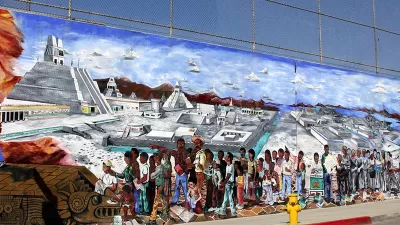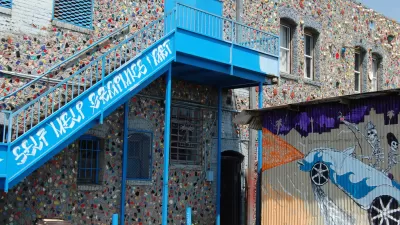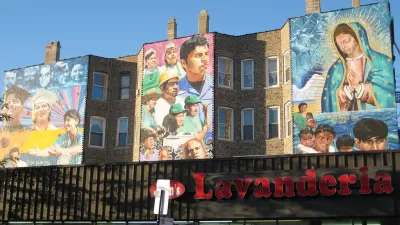Fifty years after the Chicano Moratorium, James Rojas reflects on the future of Latino Urbanism.

James Rojas marks the 50th anniversary of the Chicano Moratorium, a protest against the conscription of young Chicanos to serve in the Vietnam war, with a reflection on the meaning of Latino Urbanism, specifically in East Los Angeles.
Since the protest, which ended in violent disbandment by Los Angeles County sheriffs, Chicano urbanists have reshaped the visual landscape of East Los Angeles. "The charred aftermath of the Chicano Moratorium marked the physical end of Anglo-dominated modernism in East L.A.," writes Rojas.
Departing from the status quo in placemaking, Chicano visionaries, including artists, architects, and citizens, invented and implemented their own unique urban design interventions, says Rojas:
East Los Angeles became the visual manifestation of Aztlan, the mythical region where the Aztecs are said to have originated from. Aztlan was scrawled on many walls alongside gang graffiti. Murals educated and celebrated the power and struggle of the community and were painted on the blank walls of the private and public buildings. ASCO, a group of Chicano artists based in East L.A., used ephemeral interventions, such as a dinner party in a traffic island, performative murals, and sidewalk parades down Whittier Boulevard to create identity through the use of public space.
Looking at East Los Angeles today, the architectural influence of the Latin American architectural movement is clear. Born in the 1960s as the brainchild of a group of Chicano planners and architects, East Los Angeles' El Marcadito was designed "as a community event space based on the design of a market in Guadalajara, Mexico," and stands as a popular reminder of the success and influence of Latino Urbanism.
Given the vibrant relationship of Chicano residents with the built environment, Rojas ends the piece with a pertinent question: "Will Anglo culture assimilate into Latino culture? Or will Anglo landscape incorporate Latino urbanism?"
FULL STORY: The Chicano Moratorium and the Making of Latino Urbanism

Planetizen Federal Action Tracker
A weekly monitor of how Trump’s orders and actions are impacting planners and planning in America.

San Francisco's School District Spent $105M To Build Affordable Housing for Teachers — And That's Just the Beginning
SFUSD joins a growing list of school districts using their land holdings to address housing affordability challenges faced by their own employees.

The Tiny, Adorable $7,000 Car Turning Japan Onto EVs
The single seat Mibot charges from a regular plug as quickly as an iPad, and is about half the price of an average EV.

Seattle's Plan for Adopting Driverless Cars
Equity, safety, accessibility and affordability are front of mind as the city prepares for robotaxis and other autonomous vehicles.

As Trump Phases Out FEMA, Is It Time to Flee the Floodplains?
With less federal funding available for disaster relief efforts, the need to relocate at-risk communities is more urgent than ever.

With Protected Lanes, 460% More People Commute by Bike
For those needing more ammo, more data proving what we already knew is here.
Urban Design for Planners 1: Software Tools
This six-course series explores essential urban design concepts using open source software and equips planners with the tools they need to participate fully in the urban design process.
Planning for Universal Design
Learn the tools for implementing Universal Design in planning regulations.
Smith Gee Studio
City of Charlotte
City of Camden Redevelopment Agency
City of Astoria
Transportation Research & Education Center (TREC) at Portland State University
US High Speed Rail Association
City of Camden Redevelopment Agency
Municipality of Princeton (NJ)





























